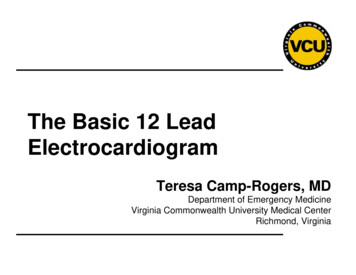
Transcription
The Basic 12 LeadElectrocardiogramTeresa Camp-Rogers, MDDepartment of Emergency MedicineVirginia Commonwealth University Medical CenterRichmond, Virginia
Objectives How do they work?Common mistakesHow to read an EKGArtifactsCases
What is an EKG? Tracing of electrical activity of the heart
History of the EKG William Einthoven Early 1900’s String galvanometer
How does an EKG work?VoltmeterSalineBucketSalineBucket
How does an EKG work?
How does an EKG work?
How does an EKG work? Einthoven I, II, III
How does an EKG work? Wilson augmented leads aVF, aVR, aVL
How does an EKG work? Pre-cordial leads V1 – V6 Standardized in 1938 by the AHA
Why PQRST? Uncorrected tracings – ABCD Corrected tracing – PQRST– Familiar with Descartes– Middle of alphabet (afterthought)
Indications Chest painSyncopeShortness of breathNausea/VomitingPalpitationsDiaphoresisStroke symptomsBefore and after cardioversionHemodynamic instabilitySuspected electrolyte disorderOverdoseArrhythmia
Common Mistakes Limb lead placementRIGHTWRONG
Common Mistakes Pre-cordial lead placement– Angle of Louis– V1– What about breasttissue?
How to read an EKG The Paper The Waveform The Plan
How to read an EKG The paper– Up and down 1 box 0.1 mV– Across 1 box 4 ms The rate– 10 seconds per page
How to read an EKG The Waveform
How to read an EKG P wave
How to read an EKG PR segment
How to read an EKG QRS complex
How to read an EKG ST segment
How to read an EKG T wave
How to read an EKG QT/QTc
How to read an EKG R-R
The Plan Rate Rhythm Axis Interval Disease
Rate 300 method– 300, 150, 100, 75, 60
Rate 10 second method Each EKG is 10 seconds Count total QRS complexes Multiply by 6
Rate Normal60 – 100 Bradycardia 60 Tachycardia 100
Rhythm SinusAtrialSupraventricularJunctionalNarrow QRSWide QRS Ventricular
Rhythm Normal Sinus Sinus Arrhythmia Sinus Arrest
Rhythm ATRIAL– Atrial Flutter– Atrial Fibrillation– Premature AtrialContraction
Rhythm Supraventricular– Catch all term– SupraventricularTachycardia
Rhythm JUNCTIONAL– Junctional Escape– Accelerated Junctional– Premature JunctionalContraction
Rhythm VENTRICULAR– V Fibrillation– V Tachycardia– Premature VentricularContraction
Axis General direction of electrical activity Will not change your management
Interval PR– Block between atria and ventricles– Heart Block First, second, and third degree QRS– Block in the conduction system– Bundle Branch Block LBBB, LAFB, LPFB, RBBB QT/QTc
P-R Interval 1 o heart block 2 o heart block - Type I 2 o heart block- Type II 3 o heart block (complete)
QRS Interval QRS complex ventricular depolarization QRS widening delay in depolarization
QRS Interval Causes of QRS widening– Ventricular rhythm– Damage to the conduction system BBB MI– Metabolic/Drugs
QRS Interval
QT/QTc Interval QT– Normal– Prolonged
EKG Artifact 60 Hz interference Muscle tremor Wandering baseline
12 leads So far we’ve just done basic rhythmrecognition with a single lead. What about the other 11 leads?
12 leads Each lead represents a different view ofthe heart More better.
12 leads II p waves Axis Diseases––––Myocardial infarctionPEHyperkalemiaPericarditis
Practice
Practice
Practice
Practice
– 10 seconds per page. How to read an EKG The Waveform. How to read an EKG P wave. How to read an EKG PR segment. How to read an EKG QRS complex. How to read an EKG ST segment. How to read an EKG T wave. How to read an EKG QT/QTc. How to










